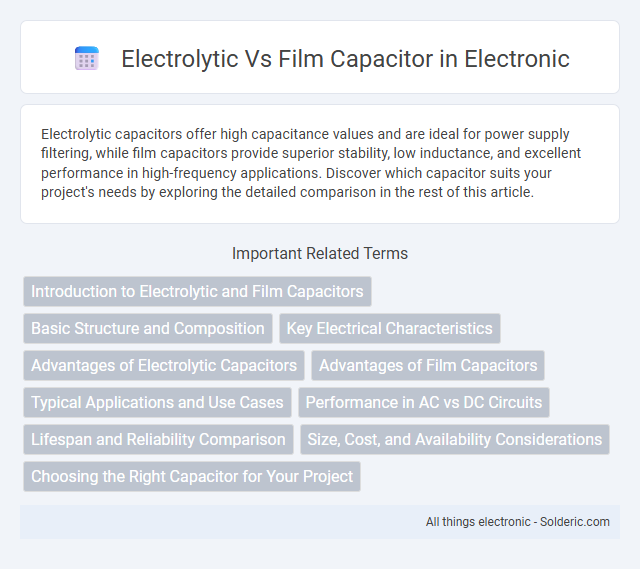Electrolytic capacitors offer high capacitance values and are ideal for power supply filtering, while film capacitors provide superior stability, low inductance, and excellent performance in high-frequency applications. Discover which capacitor suits your project's needs by exploring the detailed comparison in the rest of this article.
Comparison Table
| Feature | Electrolytic Capacitor | Film Capacitor |
|---|---|---|
| Dielectric Material | Oxide layer (aluminum or tantalum) | Plastic film (polyester, polypropylene) |
| Capacitance Range | 1 uF to several mF | 1 pF to several uF |
| Voltage Rating | Low to medium (up to ~500 V) | Low to high (up to several kV) |
| Equivalent Series Resistance (ESR) | Higher ESR | Low ESR |
| Lifetime | Limited (hundreds to thousands of hours) | Long (up to decades) |
| Polarity | Polarized | Non-polarized |
| Applications | Power supply filtering, audio coupling | Signal processing, high-frequency filtering |
| Size | Compact for high capacitance | Bulky for same capacitance |
| Cost | Lower cost | Higher cost |
Introduction to Electrolytic and Film Capacitors
Electrolytic capacitors use an electrolyte as one of their plates, providing high capacitance values ideal for power supply filtering and energy storage, while film capacitors utilize a thin plastic film as the dielectric, offering superior stability, low leakage current, and long lifespan. Your choice depends on application needs; electrolytic capacitors are suitable for applications requiring large capacitance in a compact size, whereas film capacitors excel in high-frequency and precision circuits due to their reliability and performance. Understanding these fundamental differences helps optimize circuit design and enhance overall electronic device efficiency.
Basic Structure and Composition
Electrolytic capacitors consist of an anode made from a metal foil coated with an oxide layer that acts as the dielectric, paired with a liquid or solid electrolyte serving as the cathode. Film capacitors utilize thin plastic films, such as polyester, polypropylene, or polycarbonate, as the dielectric material, with metalized or foil electrodes laminated on either side. The fundamental difference lies in the electrolytic capacitor's use of a chemical electrolyte for charge storage, whereas film capacitors rely on solid polymer or plastic dielectrics for stability and reliability.
Key Electrical Characteristics
Electrolytic capacitors typically offer high capacitance values, ranging from 1 uF to several thousand uF, making them ideal for applications requiring bulk energy storage and smoothing. Film capacitors provide lower capacitance, usually up to a few microfarads, but excel in stability, low equivalent series resistance (ESR), and low dielectric absorption for precise filtering and timing circuits. Your choice depends on voltage rating, frequency response, and longevity needed in your specific electronic design.
Advantages of Electrolytic Capacitors
Electrolytic capacitors offer significantly higher capacitance values compared to film capacitors, making them ideal for applications requiring large energy storage and filtering, such as power supply smoothing and audio equipment. They are also more cost-effective and compact for high-capacitance ratings, providing efficient solutions in space-constrained electronic designs. Their ability to handle higher voltage levels with relatively minimal size enhances their versatility in power electronics and industrial applications.
Advantages of Film Capacitors
Film capacitors offer superior electrical stability, lower equivalent series resistance (ESR), and longer lifespan compared to electrolytic capacitors. Their excellent frequency response and low dielectric absorption make them ideal for high-frequency and precision applications. Moreover, film capacitors demonstrate better thermal characteristics and reliability under varying environmental conditions.
Typical Applications and Use Cases
Electrolytic capacitors are commonly used in power supply filtering, audio equipment, and applications requiring high capacitance values at a low cost, but they generally have higher equivalent series resistance (ESR) and limited frequency response. Film capacitors excel in precision electronics, signal processing, and high-frequency applications due to their low ESR, stable capacitance, and long lifespan, making them ideal for circuits demanding high reliability and accuracy. Your choice between electrolytic and film capacitors should consider the specific requirements of voltage, frequency, and longevity in your electronic designs.
Performance in AC vs DC Circuits
Electrolytic capacitors typically perform better in DC circuits due to their higher capacitance values and voltage ratings but exhibit higher Equivalent Series Resistance (ESR), which limits their effectiveness in AC applications. Film capacitors offer superior performance in AC circuits by providing low ESR, lower dielectric losses, and better frequency response, making them ideal for signal coupling and filtering tasks. Your choice depends on whether stable capacitance and longevity in DC or efficient, low-loss operation in AC is prioritized.
Lifespan and Reliability Comparison
Electrolytic capacitors typically have shorter lifespans, ranging from 1,000 to 10,000 hours depending on temperature and voltage stress, while film capacitors can last over 100,000 hours due to their stable dielectric materials. The reliability of film capacitors surpasses electrolytic types with lower leakage currents, better thermal stability, and resistance to aging and humidity, making them ideal for long-term applications. Choosing the right capacitor impacts your circuit's durability, especially in critical or high-reliability environments.
Size, Cost, and Availability Considerations
Electrolytic capacitors generally offer higher capacitance values in a smaller size compared to film capacitors, making them suitable for power supply filtering and bulk storage applications. Film capacitors, while larger and more expensive, provide superior stability, low ESR, and longer lifespan, often used in precision circuits and audio applications. Electrolytic capacitors are widely available and cost-effective for high-capacitance needs, whereas film capacitors, though pricier, are favored for reliability and performance in specialized electronic equipment.
Choosing the Right Capacitor for Your Project
Electrolytic capacitors offer high capacitance values and are ideal for power supply filtering and bulk energy storage, while film capacitors provide superior stability, low ESR, and longer lifespan, making them suitable for precision applications and signal processing. Selecting the right capacitor depends on factors such as voltage rating, tolerance, frequency response, and temperature stability specific to your project's requirements. Careful evaluation of these parameters ensures optimal performance, reliability, and cost-effectiveness in electronic circuit design.
Electrolytic vs film capacitor Infographic

 solderic.com
solderic.com